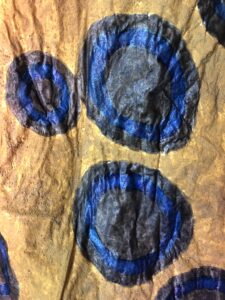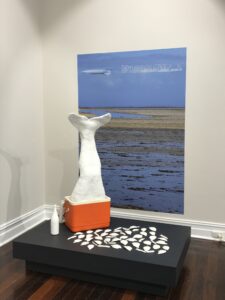An exhibition curated by Kerry Youde, about her family’s shack on the Yorke Peninsula.
Exhibition dates; November 12 to December 24 2020.
“- A deep dip into childhood memory and imagination, with a bit of history and augmented reality thrown in”.

Image by Kerry Youde, from The Shack Exhibition.
Inviting a handful of regional and metropolitan artists , Kerry Youde asked them to respond to their connection to ‘the shack’, its environment and history, all of the artist having spent time in and around the Shack .
I was fortunate enough to be one of the invited artist and the following are some snippets into the construction of my Fish traps, and an explanation on how they relate to the Shack .

My Fish Traps in situ at The Shack Exhibition.
The use of traps to catch fish has a long history. Around the world, people have designed and made these traps throughout history, using different materials and shapes, dictated by the resources and fish available in the area. There are two types of trap, a permanent or semi-permanent structure placed in a river or tidal area and a more permanent type. The traps that the Narrunga/Adjahdura people, living at Black Point used, are of the more permanent type, constructed out of rocks. Remnants of these can still be seen along the coastline.



My traps are constructed from split and dried reeds, they make up the ‘skeleton’. This construction is covered with several layers of thin paper, held together with a wheat paste. Clay, collected from my Clare Valley property, sumi-e ink, which is made from soot and burned wood, a handmade brown ink, from walnut hulls and a blue writing ink, decorates each trap with a different pattern. The patterns are inspired by sea creatures. Featured are Blue Ringed Octopus, Pajama Striped Squid, Larger Pacific Striped Octopus, Fiddler Ray and Mimic Octopus.





As long back as the Vikings, Ochre has been used, not only for decorating their long houses, but also in colouring the rune stones, which are known mostly around Scandinavia, but also from places around Europe where the Norsemen visited during the Viking age. The most common paints were red ochre, red lead, soot, calcium carbonate, and other earth colours, which were bound with fat and water. The use of these colours continues in today’s’ Norway and are very much a part of my memories of family visits and holidays over the years.
Traditionally Norwegian houses were painted a strong red, yellow, or white. White is the most popular colour. The colour the owners chose depended mostly on the family’s financial situation, geographic location and profession. Certain colours required certain resources, therefore some colours cost more or less depending on the availability and access of the various resources needed to make these paints.
I have a deep respect for Indigenous cultures, connection to the land is important to me, using natural materials strengthening this spiritual belonging with my work referencing shared links to my cultural heritage. – Maria Holst Salomonsen



The artist were; Silvana Angelakis, Steph Ball, Plaxy Folland, Julian Galvin, Gail Hocking, Maria Holst Salomonsen, Rick Hutchinson, Lis Jones Ingman, Sue Kneebone, Sue Michael, Samuel Mulcahy and Kerry Youde
I really enjoyed this opportunity , to be part of a fabulous group of artist, with such varied ways of expression, that came together in a very professional executed exhibition. A big thanks to Kerry Youde, for “birthing” the idea and bringing it to life.
A link to Kerry’s website , if you are curious and want to know more about the shack project.
